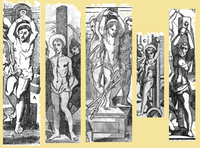Crux simplex

The crux simplex is an instrument of torture and execution recognized by modern authors as one of the types of crosses that existed in the ancient world. In the sixteenth century the scholar Justus Lipsius (1547–1606) qualified itself in his book De cruce libri tres. Most recently as archaeologists and historians like Joe Zias, (Antiquities Museum Jerusalem) and Frederick T. Zugibe[1] have recognized that the crux simplex, consisting of only a vertical beam without crossbar, "in fact is a kind of crucifixion". This type of cross"was the easiest available way to torture and kill criminals". Indeed it isthe most common form of crosses used by the Persians, Assyrians, Seleucids and Phoenicians.
Etymology
The word crux in Latin, in pre-imperial Rome to the gibbet or stake, a wooden instrument for executions,[2] but not necessarily to intersecting or "cruciform" beams.[3] The Latin word derived from the verb crucio "to torture" (c.f. English excruciate).[4] The addition of a transverse bar, to which the criminal would be fastened with nails or cords, dates to a later period, and the simple pole was specified as crux acuta or crux simplex for disambiguation.
Crucifixion before Rome


Crucifixion probably originated with the Assyrians and Babylonians. The Assyrians impaled their victims by the ribs and left them hanging on spears or high stakes.
Later this method of execution was adopted by the Persians who used it systematically during the sixth century BCE. The Hebrew Bible (OT) testifies to this Persian practice, when it reads that Darius I the Great issued an order that no one interfere in rebuilding the temple in Jerusalem on pain of being set (literally, "elevation") on a tree ripped from your own home.[5] During the reign of Ahasuerus (Xerxes I), the son of Darius, two of the guardians of the palace gate were hung or attached to a pole, the usual punishment Persians gave traitors.[6] Haman and his ten sons were hung on a tree for similar reasons.[7] The Greek historian Herodotus also cites other cases of application of such punishment by the Persians.[8] The Dead Sea Scrolls, which are dated as of the first century, cited Deuteronomy 21:22-23 with reference to crucifixion practiced by the Romans and later Hasmoneans.[9] For example, they applied this passage to executions by Alexander Jannaeus in the year 88 BCE. [10]
When Alexander the Great conquered the Persian Empire he adopted, among other Oriental customs, crucifixion, which was applied after the conquest of the city of Tyre when he ordered the crucifixion of about 2000 people at sea.[11] He also ordered the crucifixion of the doctor who could not save the life of his friend, Hephaistion. From the fourth century BCE onward, this practice was introduced in the eastern Mediterranean countries. There is evidence that captured pirates were crucified in the port of Athens around the 7th century BCE.
Crucifixion in Carthage was established by the Phoenicians as a method of execution, which was applied to the generals who suffered a major defeat. [12] Crucifixion was subsequently adopted by the Romans.
Crucifixion in ancient Rome
The crucifixion was a death sentence widely used in ancient Rome, being excluded for Roman citizens. It was applied to the lower classes and slaves. Cicero called it the worst tortures.
Josephus wrote in The Jewish War: "the soldiers out of rage and hatred, had fun nailing their prisoners in different postures".[13]
The eastern Phoenician crucifixion had merged with the Roman custom of the rite of "patibullum" which was to make charging inmates a wooden yoke (furca, patibulum) to the place of execution.

According to Fulda (1878): "Trees were not everywhere available at the places chosen for public execution. So a simple beam was sunk into the ground. On this the outlaws, with hands raised upward and often also with their feet, were bound or nailed".[14]
Execution by crucifixion was finally abolished by Constantine.
References
- ↑ Frederick T. Zugibe (2005). The Crucifixion of Jesus: A Forensic Inquiry. Rowman & Littlefield. p. 40-41. ISBN 9781590770702.
- ↑ "wood, tree or frame in which it is impaled, fixed or hanged criminals." T. Lewis, Charlton; Short, Charles, A Latin Dictionary. Harper and Brothers publishers. New York in 1879. Oxford University Press.
- ↑ "even among the Romans the crux (from which our cross is derived) appears to have originally been a stick upright, and this always remained the more prominent part". P. Fairbairn (1874). The Imperial Bible-Dictionary. I. London. p. 376.
- ↑ Ogechukwu, Nwaocha Mind (17 July 2010). "The Secret Behind the Cross and Crucifix". Strategic Book Publishing. Retrieved 18 June 2016 – via Google Books.
- ↑ Ezra 6:11
- ↑ Esther 2:21-23
- ↑ Esther 5:14
- ↑ Herodotus, Book III, 125, 159; IV, 43
- ↑ 11QT, Deut 64:6-13; 4QpNah, Deut 3-4:1:1-11
- ↑ Cf. Josephus' Antiquities of the Jews" 13.14.2. “The Jewish War” 1.4.5-6
- ↑ Curtius Rufus, Hist. Alex. 4.4.17.
- ↑ Livy, "Roman History" 38.48.13.
- ↑ "The Jewish War" 5:451-452)
- ↑ Hermann Fulda (1878). Das Kreuz und die Kreuzigung" (The cross and crucifixion). Breslau (Wroclaw). pp. 109, 219, 220.